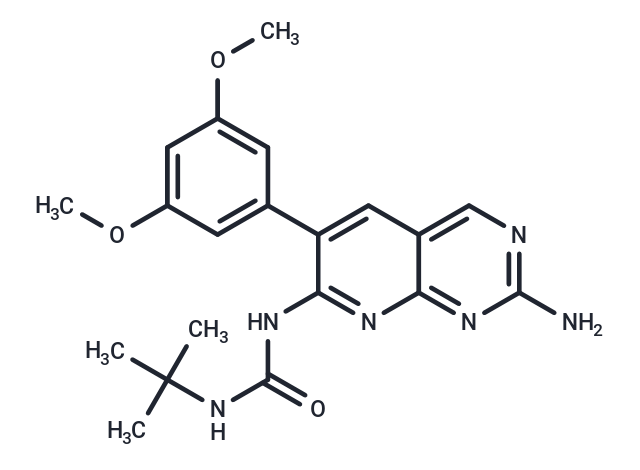Shopping Cart
- Remove All
 Your shopping cart is currently empty
Your shopping cart is currently empty

PD-166866 is a selective FGFR tyrosine kinase inhibitor.

| Pack Size | Price | Availability | Quantity |
|---|---|---|---|
| 2 mg | $34 | In Stock | |
| 5 mg | $55 | In Stock | |
| 10 mg | $87 | In Stock | |
| 25 mg | $162 | In Stock | |
| 50 mg | $321 | In Stock | |
| 100 mg | $477 | In Stock | |
| 1 mL x 10 mM (in DMSO) | $56 | In Stock |
| Description | PD-166866 is a selective FGFR tyrosine kinase inhibitor. |
| Targets&IC50 | FGFR1:52.4 nM |
| In vitro | The treatment with PD166866 apparently causes a mitochondrial deficit and an oxidative stress[1]. PD 166866 inhibits human full-length FGFR-1 tyrosine kinase with an IC50 value of 52.4 ± 0.1 nM but has no effect on c-Src, platelet-derived growth factor receptor-β, epidermal growth factor receptor or insulin receptor tyrosine kinases or on mitogen-activated protein kinase, protein kinase C and CDK4 at concentrations as high as 50 μM. PD 166866 is a potent inhibitor of basic fibroblast growth factor (bFGF)-mediated receptor autophosphorylation in NIH 3T3 cells expressing endogenous FGFR-1 and in L6 cells overexpressing the human FGFR-1 tyrosine kinase, confirming a tyrosine kinase-mediated mechanism. PD 166866 does not inhibit platelet-derived growth factor, epidermal growth factor or insulin-stimulated receptor autophosphorylation in vascular smooth muscle, A431 or NIHIR cells, respectively, further supporting its specificity for the FGFR-1. Besides, PD 166866 is found to be a potent inhibitor of microvessel outgrowth (angiogenesis) from cultured artery fragments of human placenta. Phosphorylated 44- and 42-kDa MAPK isoforms are inhibited in L6 cells by PD 166866 with IC50 values of 4.3 and 7.9 nM, respectively[2]. PD166866 induces autophagy through repressing Akt/mTOR signaling pathway[3]. |
| Cell Research | HeLa cells are treated with PD166866 for 24 hours, the growth medium is removed, the cells are washed with PBS and fixed for 1 hour at 25°C adding a freshly made paraformaldheyde solution (4% in PBS). Samples are washed again with PBS and the endogenous oxidases were blocked for 2 minutes in the dark. Further washes with PBS followed and blocking the unspecific sites is done for 1 hour at 25℃. PARP is evidenced by immunolocalization utilizing a polyclonal antibody, directed against the N-terminal proteolytic fragment. Immuno-reaction is revealed by a secondary anti-rabbit antibody after incubation for 16 hours at 4°C. After exhaustive washing with PBS the samples are incubated for 30 minutes in solution ABC. Eventually, DAB (3,3'-Diaminobenzidine) is added and the samples are incubated for 10 minutes in the dark. The samples are washed again the plates are sealed and ready for microscopic observation.(Only for Reference) |
| Alias | PD166866 |
| Molecular Weight | 396.44 |
| Formula | C20H24N6O3 |
| Cas No. | 192705-79-6 |
| Smiles | COc1cc(OC)cc(c1)-c1cc2cnc(N)nc2nc1NC(=O)NC(C)(C)C |
| Relative Density. | 1.277g/cm3 |
| Storage | Powder: -20°C for 3 years | In solvent: -80°C for 1 year | Shipping with blue ice. | ||||||||||||||||||||||||||||||
| Solubility Information | DMSO: 12 mg/mL (30.3 mM) H2O: < 1 mg/mL (insoluble or slightly soluble) Ethanol: 3 mg/mL (7.57 mM) | ||||||||||||||||||||||||||||||
Solution Preparation Table | |||||||||||||||||||||||||||||||
Ethanol/DMSO
DMSO
| |||||||||||||||||||||||||||||||

Copyright © 2015-2024 TargetMol Chemicals Inc. All Rights Reserved.